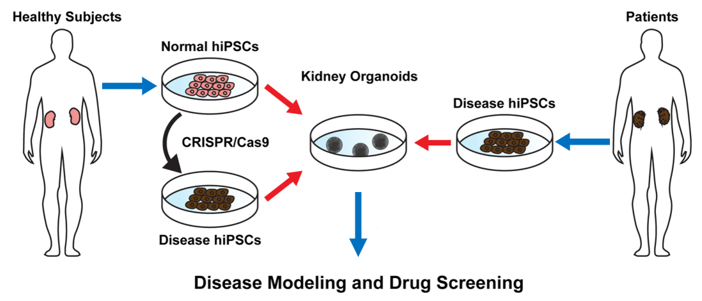The kidney is a complex organ composed of more than 20 different types of cells, which are constructed into anatomical and functional units including the glomerulus, and proximal and distal tubules. The functions of the kidney include fluid homeostasis, removal of nitrogenous waste products, and the regulation of blood pressure, bone density and red blood cell count. Kidney diseases can result from genetic mutations but can also occur after chronic injuries, such as inflammatory diseases and diabetes. As the main target of toxic injury, the kidney is also extremely susceptible to drug-induced toxicity. The result of all these conditions is that chronic kidney disease is increasing at a rate of 6% per year worldwide, whereas end-stage kidney disease remains treatable only via dialysis or transplantation.
Compared with liver, heart or cartilage, it is difficult to establish functional human renal cells and tissues composed of different cell types. The advent of stem cell-derived models of the human kidney has been of significant interest to the nephrology community as potential models for the screening of drugs, improved understanding of disease etiology, and sources of replacement renal tissue.
Being able to engineer human organoids in a dish will greatly improve our ability to cure and manage kidney diseases, and fundamentally change the way we conduct biomedical research. First, it will allow scientists to study the disease and explore new therapies directly on human tissue, which will greatly improve the translatability of drug candidates. Second, organoids can be used to model normal human development and disease in a personalized way. Finally, and most importantly, organoids can be used in replacement therapies, which will enable unlimited production of transplantable tissues and will solve the problem of organ shortages once and for all.

By taking human pluripotent stem cells and adding small molecules and growth factors, OrganoLab has established a kidney organoid model that can replicate many of the functions of human kidney. This model provides a platform for in-depth study of both organ growth and the response of kidney tissue to injury, fibrosis, and drug therapy. We also use advanced genome editing techniques to introduce mutations that are present in humans in order to understand the cellular effects of those mutations.
References
- Ding, B. et al.; Three-Dimensional Renal Organoids from Whole Kidney Cells: Generation, Optimization, and Potential Application in Nephrotoxicology In Vitro. Cell Transplantation, 2020.
- Miyoshi, T. et al.; Kidney organoids in translational medicine: Disease modeling and regenerative medicine. Dev Dyn. 2020, 249(1): 34-45.
- Little M. H. et al.; Kidney organoids: accurate models or fortunate accidents. Genes Dev. 2019, 33(19-20): 1319-1345.
- Tian P. et al.; The myriad possibility of kidney organoids. Curr Opin Nephrol Hypertens. 2019, 28(3): 211-218.
Online Inquiry